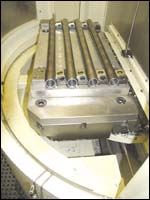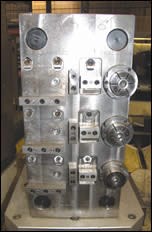Shop Gets Fixturing On The Ball
An integrated mounting system enabled this producer of specialty medical tables to improve throughput and reduce setups. As a result, a significant number of jobs have been brought back in-house.
Share




When John Zezulka at Orthopedic Systems Inc. (OSI) drafted a proposal to convince his senior management to modernize tooling and fixtures, the machine shop supervisor realized that the Union City, California company could attain greater efficiencies by implementing an integrated workholding system. Mr. Zezulka determined that reduced setups were also possible.
The traditional workholding methods (one vise for one part, four vises for four parts and so on) adopted by the company for machining on its Haas VF4, Kitamura 400 and 3Xi and two Fanuc Robodrills yielded time-consuming change-overs.
“We needed a more advanced way to hold parts, such as a product or combination of products that would streamline setups and allow machining of multiple components in the same machining space,” says Mr. Zezulka. “Optimizing use of the tables and the travel on the CNC machining center was another goal.” As a result of introducing the Ball Lock mounting system from Jergens Inc. (Cleveland, Ohio), OSI was able to reduce throughput, increase productivity and bring numerous jobs back in-house.
In business for more than 25 years, OSI has 300 employees and one assembly plant. The company builds specialty tables that are commonly used by orthopedic surgeons in hip replacement, knee, shoulder and spine surgeries, as well as procedures associated with trauma injuries. The majority of the components requisite for such tables are constructed of stainless steel, plastic and some aluminum. In regard to tolerances, Mr. Zezulka says the company works within tight constraints. Because certain tables OSI produces must accommodate heavy loads, rigidity is crucial.
An earlier discussion with engineers sparked Mr. Zezulka’s interest in the Jergens system. He realized at that point that a more advanced way to hold parts could potentially foster quick setups, multiple parts in the same machining space and optimal use of the travel on the CNC machining center.
On a monthly basis, OSI processes an average of 100 job orders, all of which are repeat jobs, on its Haas machining center alone. A significant source of revenue, these repeat jobs call for continual setups that often entailed cutting soft jaws, taking vises on and off of the machines, and indicating fixtures and vises. The added labor hours required for setup and fixturing were also costly. This previous workholding method translated to a change-over time (per machining center) of 60 to 90 minutes per part operation. Cycle times, including loading and unloading the part, ranged from 5 to 8 minutes.
Pre-engineered to fit the Haas machining center used by OSI, the Jergens Ball Lock mounting system replaced the standard vise tooling at the company, thus enabling machining of multiple parts per load. The system functions to locate and lock fixture plates to subplates in seconds. Receiver bushings are installed in the machine table or subplate, while liner bushings are mounted in the fixture plate. Locating shanks are then inserted through the liners and into the receivers to provide accurate location, says the manufacturer. Each locating shank contains three locking balls that are deployed with a couple of turns of an actuating setscrew. Once in place, each of the locating shanks provides a positive holding force of up to 20,000 lbs per shank. According to the manufacturer, the system eliminates the necessity of indicating fixtures, yet it provides repeatability and positioning accuracy of ± 0.0005".
Company: Orthopedic Systems Inc. (OSI)
Problem: Conventional fixtures limit machine capacity
Solution: Ball Lock mounting system from Jergens Inc.
Results: Multiple part setups, improved throughput
The company has discovered another advantage: being able to use more of the available worktable space. For instance, the OSI approximates that just 96 of a total of 1,000 square inches were previously used. Additional parts can now be placed on the surface rather than just one. Change-overs have been reduced to 1 to 5 minutes. In addition, the previous unload/load time has been reduced by 50 percent.
In his initial proposal, Mr. Zezulka calculated that, for several part numbers in particular consisting of 1inch square material (loaded one by one), the time allotted for cutting the soft jaws is 1 hour, with a run time ranging between 3 and 6 minutes. He thought that when setting up each of these parts on a single tooling plate—cutting as many as six parts per load—all part programs could be taken from a known position on the tooling plate with a reduction in setup and cycle times of 50 percent.
“The results definitely exceeded our expectations,” reports Mr. Zezulka. “Setups were reduced by more than 60 percent with this particular group.
“Overall throughput for the product family was decreased as well—from 36 days to 7 days door-to-door time,” he adds.
“Based on the number of parts we produce, we recouped the investment in 2 months,” says Mr. Zezulka. “This takes into account the sum of the savings per part.”
The interchangeability of the fixture plates has been beneficial as well. They can be used on virtually all of the company’s CNC machining centers. Many of the manufacturer’s fixtures can hold a family of parts, in turn reducing the number of tooling plates needed.
“This means that the fixtures can be transported from machine to machine as needed,” explains Mr. Zezulka.
According to Ed Feifert, account manager for Jergens distributor K&H Sales, OSI has incorporated several of the mounting systems since the first project, all of which have resulted in increased productivity for the shop.
Mr. Zezulka points out that the company previously outsourced close to 60 percent of its work. Within the past 3 years, however, it has gradually been able to bring a substantial number of jobs back in-house through reduced throughput and tooling costs.
Read Next
5 Rules of Thumb for Buying CNC Machine Tools
Use these tips to carefully plan your machine tool purchases and to avoid regretting your decision later.
Read MoreSetting Up the Building Blocks for a Digital Factory
Woodward Inc. spent over a year developing an API to connect machines to its digital factory. Caron Engineering’s MiConnect has cut most of this process while also granting the shop greater access to machine information.
Read MoreRegistration Now Open for the Precision Machining Technology Show (PMTS) 2025
The precision machining industry’s premier event returns to Cleveland, OH, April 1-3.
Read More
























.png;maxWidth=300;quality=90)







